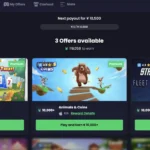Contents
Building your audience
Imagine being able to share your content with hundreds or even thousands of people with just one click. That’s the power of building an audience. Building an audience means getting people to follow you so that you can reach them whenever you want.
How Can You Build an Audience from Scratch?
Use Lead Magnets to Get Email Subscribers
If there’s one channel I recommend investing in to build your audience, it’s your email list. Here’s why: your email list will always belong to you. As long as they permit, you can reach your audience anytime.
To build an email list, you need to give your blog visitors a reason to subscribe. Most blogs use lead magnets—a free resource offered in exchange for a visitor’s email address. like this

You don’t have to be an author to attract people to sign up. Anything can be a lead magnet, as long as it provides value to your audience. You can even have multiple types of lead magnets. It could be an ebook, a course, templates, checklists, reports, or any other content you can think of. Check out our post for more lead magnet ideas you can use.
Once you have your lead magnets, you’ll want to promote them as much as possible (but not so much that it disrupts the reading experience on your blog). For example, we have a simple “Sign up for our newsletter. We’ve added this Subscribe button to the top of blog posts and as a sticky opt-in box on the side.
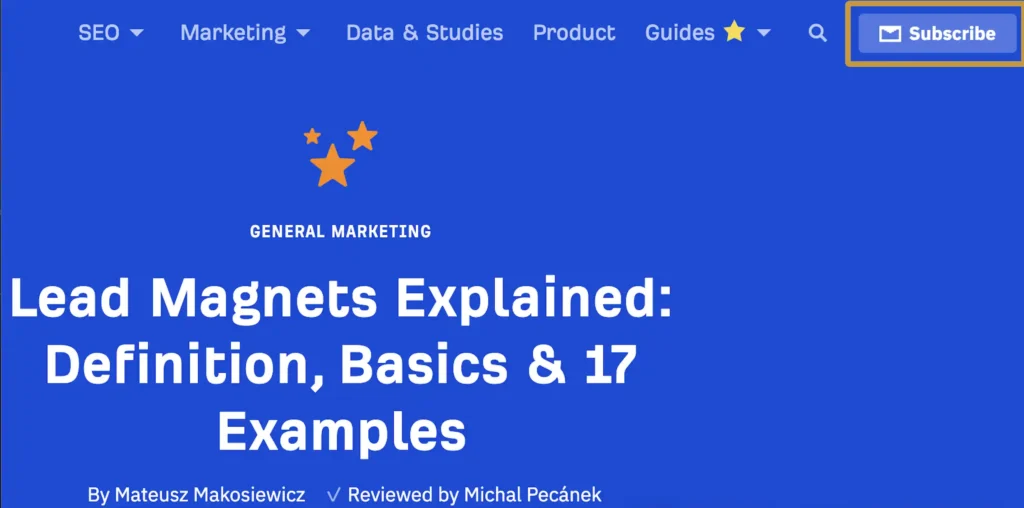
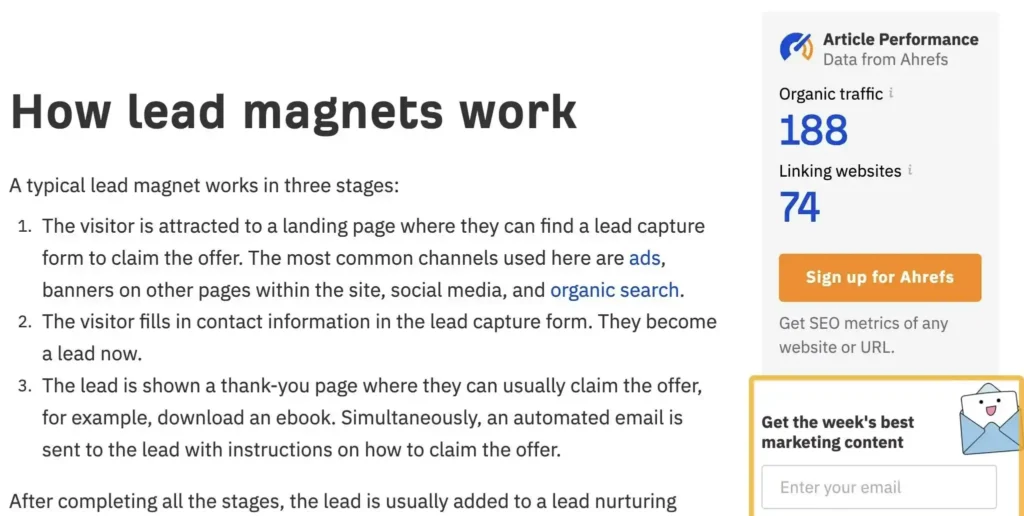
Once you start building your email list, it’s important to stay in regular contact with your subscribers. You can send an email every time you publish new content (as we’ve done in the past), or organize the emails according to your preferred schedule. For example, we send out a weekly newsletter.
Create a Private Community on Facebook
Anyone can create a group on Facebook. It’s free, easy to set up, and anyone with a Facebook account can join your group right away. You can also take advantage of Facebook’s algorithm to promote your group.
Then, you can promote your blog by posting links to your new posts or by sharing insights from your posts directly within the group.
When it comes to building a community, more isn’t always better. Facebook groups often suffer from the “tragedy of the commons”—unrestricted access can lead to spam, abuse, and other bad internet behavior that can destroy the group. That’s why I strongly recommend setting your group to private and carefully vetting potential members.
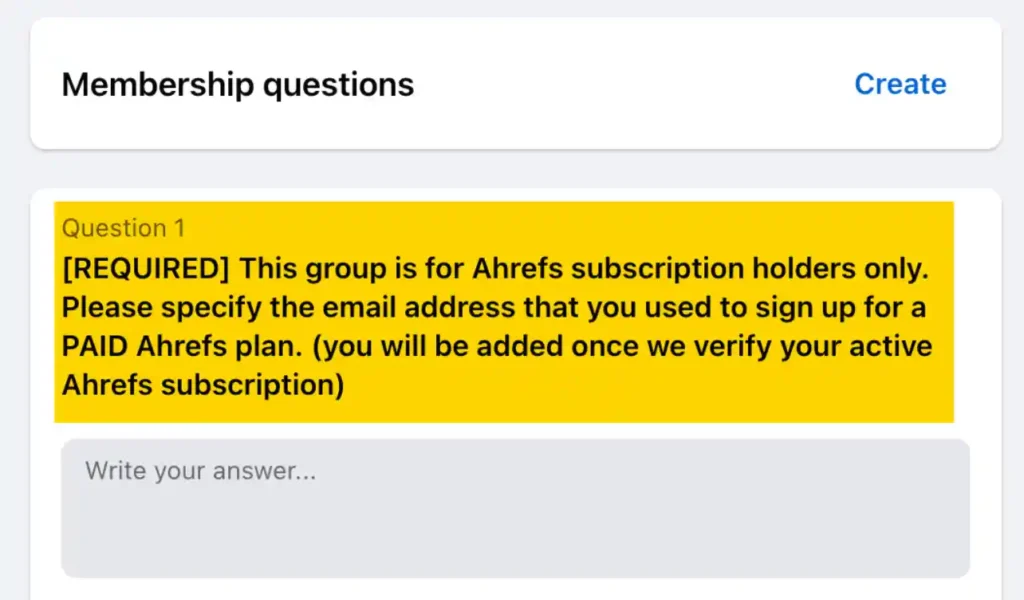
That said, you’ll still need to invest in moderation. Just because someone has a stake in the group doesn’t mean they won’t cause trouble. You’ll need to regularly step in to remove offensive posts, delete hateful comments, and ban spammers to maintain a healthy community.
Building Followers on X (formerly Twitter) or LinkedIn
I recommend X and LinkedIn because these platforms can potentially drive traffic to your blog. (I mean, people on YouTube and TikTok are there to watch videos, right?) But here’s the thing: unlike the good old days, you can’t just post a link to your blog and expect clicks. Social media platforms want to keep you on their turf, so they’ve started limiting the reach of posts that contain links.
If you want to build followers on X or LinkedIn, I recommend creating zero-click content. This type of content provides valuable insights on its own without requiring a click. You don’t have to start from scratch either—just repurpose tips, insights, and strategies from your existing content.You can add a link back to your blog post at the end of the thread or in the comments. You can even direct them to sign up for your email list.
Partnering with audience
Blogs are similar—you need visitors to build an audience, but you also need an audience to attract visitors. Unlike a work puzzle, you can solve this by “borrowing” an audience. Borrowing an audience means finding where your target audience is already spending time online and putting your content in front of them. Here are some strategies you can use to do this:
- Guest Posting: Write articles for popular blogs in your niche to showcase your expertise and link back to your site.
- Collaborations: Partner with influencers or creators to share content, widening your reach.
- Engage in Communities: Join relevant forums, groups, or social media communities and actively participate by offering valuable insights and sharing your content when appropriate.
Optimize Your Content to Rank on Google
Google is the best place to attract an audience. Search traffic is predictable, cumulative, cost-effective, and highly targeted. To get traffic from Google, you can’t just write about random topics. You need to write about topics people are actively searching for. Here’s how to find topics that users are searching for on Google:
- Go to Ahrefs Keyword Explorer.
- Enter a topic related to your blog (for example, if you have a blog about the keto diet, enter “keto”).
- Navigate to the “Matching Terms” report.
- Switch the tab to “Questions” to discover the specific queries people are asking.
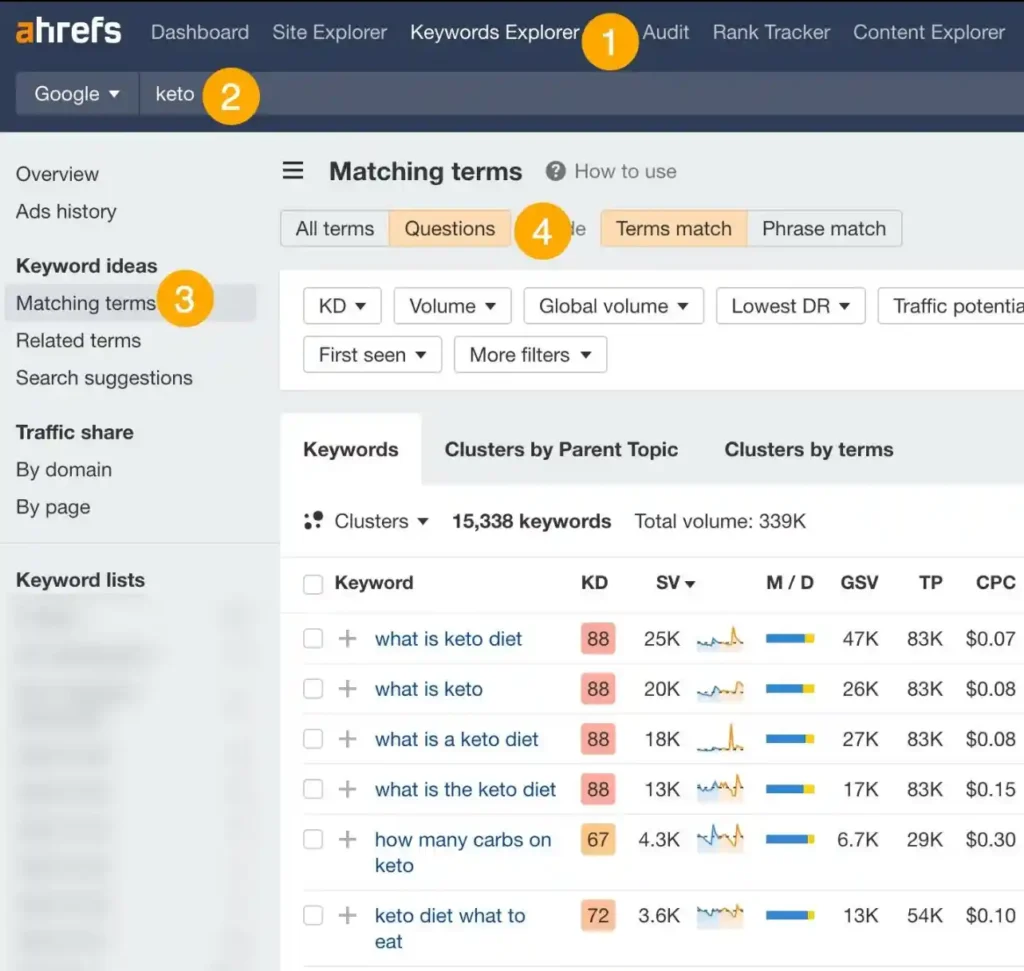
Browse through the list to see if there are any potential keywords you can target. Once you’ve selected a topic, you’ll want to figure out why searchers are looking for that specific keyword. Understanding this “why,” or search intent, will help you create content that matches what searchers want to see.
You can determine search intent by looking at the content already ranking on Google. The easiest way to do this is to enter your target keyword into your keyword analysis tool, scroll down to the SERP overview, and click to analyze the intent.
For example, if we do this for the topic “what to eat on a keto diet,” we can see that searchers are looking for a list of foods that are allowed on the diet.
Therefore, when writing our article, we want to tailor our blog post to answer the specific questions that searchers have about this topic. This way, our content directly addresses their needs and aligns with the search intent, increasing its chances of ranking well on Google.
Offer to Update Others’ Posts
If you can find posts on other websites with declining search traffic, they may just need an update to regain their rankings and traffic. By proactively offering to provide those updates and subtly linking to your content within the refreshed post, you can promote your blog to potentially thousands of people each month.
Here’s how you can find content with declining organic traffic:
Go to Ahrefs Content Explorer.
Search for your topic.
Set a minimum page traffic filter (e.g., >500) so you only target pages that are worth your time.
Toggle the filter for explicit results.
Set the language filter to your target language.
Check the box to exclude homepages and subdomains.
Set the “Trend” dropdown to “Last year” to find pages that have seen a drop in traffic.
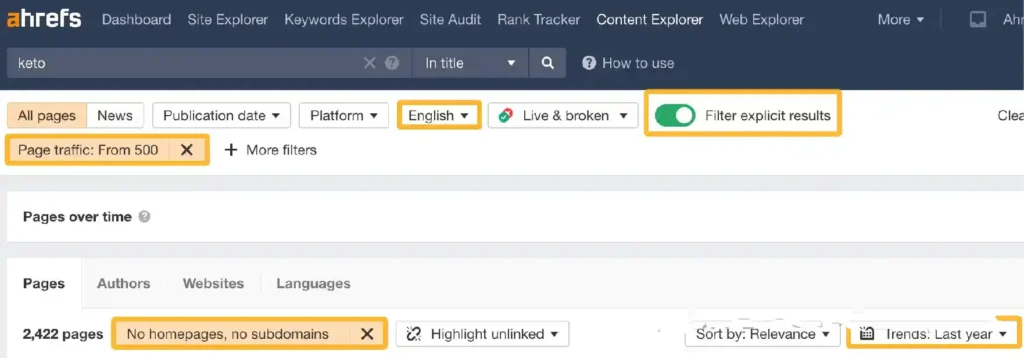
Browse through the list and look for pages with declining traffic. For example, an article like the one from PureWowmight be a great candidate. Identify these pages and consider offering your updates to help improve their ranking and performance, while also finding opportunities to subtly link back to your own content.

Reach out to the editors and see if they’re interested in updating the post. Sweeten the deal by offering to do the work for them and optimize the post to rank higher on Google, just like Irina Maltseva, former marketing director at Hunter, successfully did. This approach provides value to them while also benefiting your own blog’s visibility.
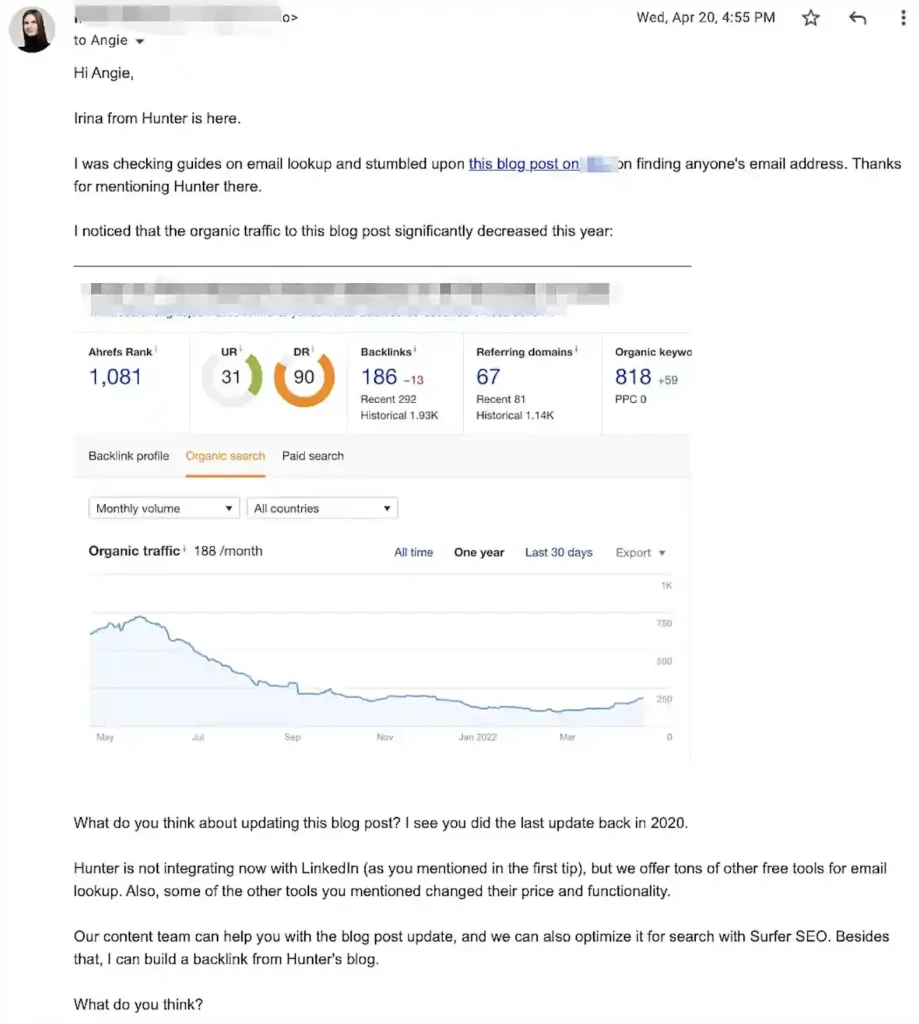
Sharing Bare-Bones Posts on Reddit
Almost anything has a subreddit. If done right, you can tap into Reddit’s massive audience and drive significant traffic to your blog. However, you can’t just drop a link and expect to see a surge in visitors. Redditors hate blatant ads and marketing. If they sense even a hint of self-promotion, they won’t hesitate to downvote you into oblivion and ban you.
But, Reddit does appreciate valuable content. To avoid the wrath of Redditors, share a bare-bones version of your content. Strip out all the promotional elements, especially internal and external links. Leave only a single link at the bottom to your original post, so anyone interested can check it out.
For example, here’s what a Chief Marketing Officer (CMO), Tim Soulo, did in the subreddit r/bigSEO:
He shared a stripped-down version of his content, offering valuable insights without any direct promotion or links throughout the post. Only at the very end, he included a single link to his original article for those who wanted to dive deeper. This approach allowed him to engage with the community without coming across as overly self-promotional, gaining both credibility and traffic for his blog.
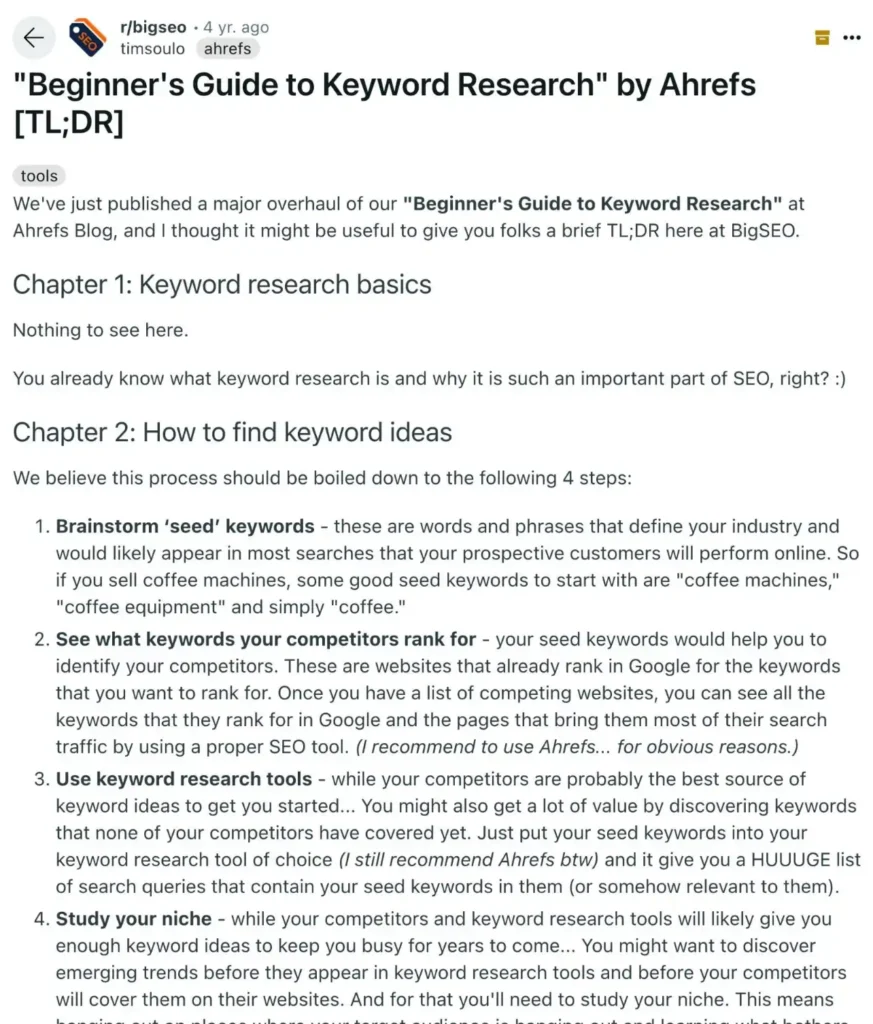
Four years later, this post remains one of the top-ranked posts in the subreddit’s history. This shows the lasting impact of providing valuable, non-promotional content that resonates with the community while subtly driving traffic to your blog.
Building Relationships with Influencers
Influencers, podcasters, YouTubers, journalists, and newsletter authors have large audiences you can borrow from. However, they have those audiences for a reason: they consistently share engaging, high-quality content, and they don’t just promote anything from anyone. To tap into their audience, you need to build genuine relationships with them by offering value and aligning your content with their standards.
Influencers, podcasters, YouTubers, journalists, and newsletter authors have large audiences you can borrow from. However, they have those audiences for a reason: they consistently share engaging, high-quality content, and they don’t just promote anything from anyone. To tap into their audience, you need to build genuine relationships with them by offering value and aligning your content with their standards.
Therefore, to “borrow” their audience, you need to build strong relationships with these individuals. You need to practice what my friend Michale calls the “Good Reply Game.” This means engaging with their content thoughtfully and consistently, offering valuable insights, and building rapport over time. By becoming a positive, contributing presence, you’ll stand out and eventually be able to collaborate or borrow their audience in a natural, mutually beneficial way.
Replies and comments are an art form, and many people—probably 60-70% of those I’ve seen online—don’t get it right. The key isn’t just to say what’s on your mind, but to support the original poster (OP). You can support them even if you disagree, or you can “wrongly support” them by agreeing in a playful or humorous way. The goal is to contribute constructively, making the conversation better while engaging thoughtfully with the content.
You want to support their work by consuming, sharing, and praising it. But you don’t want to come across as sycophantic (everyone does that) or sound like an AI. The key is to be genuine and thoughtful in your engagement. Offer meaningful feedback, share insights, or add something new to the conversation that shows you’ve truly understood and appreciated their content. This will help you stand out and build real connections without seeming insincere or robotic.

In fact, if you disagree and share your viewpoint intelligently, rather than combatively, you’ll catch their attention. Building friendships with influencers doesn’t mean expecting them to share everything you post. That kind of transactional mindset is easily detectable from a mile away, and it’s a sure way to lose potential friends. You should only share your best work with them, and do so without any expectations. If your content is genuinely good, you’ll find that they will naturally share it with their audience when it resonates with them.
Buying an Audience
If you have enough money to solve a problem, then the problem doesn’t exist. So, if you have a budget, attracting an audience isn’t an issue. You can get eyes on your content through Google Ads, social media ads (like Facebook, X, Instagram, TikTok), or newsletter ads.
If you’re new to blogging, you might think this is something you can’t do, especially if you don’t have a paid advertising budget. But remember: no strategy is truly free. Even if you’re not spending money, you’re spending time. And time is money.
Think about it: if you could spend $100 on ads and guarantee 1,000 clicks, would you do it? Compare that to spending 10 hours repurposing your content for LinkedIn and leaving your fate to the algorithm. Sometimes, it makes more sense to run ads and use your valuable time to do other things for your blog.
Summary of Blog Promotion
The blog promotion process may seem complex, but in reality, it’s quite simple. Promoting your blog across different platforms doesn’t require elaborate plans. Instead, focus on sharing the value and benefits your website offers in everyday interactions with users. By naturally highlighting how your content can help or provide insights, you’ll organically attract visitors. The key is persistence—staying consistent and dedicated to promoting your blog will yield results over time.



